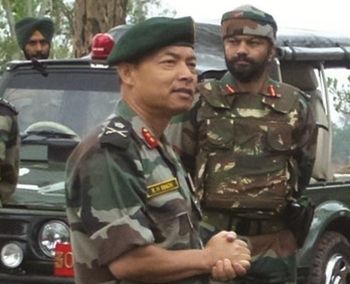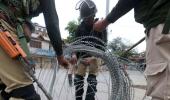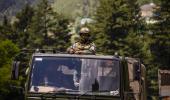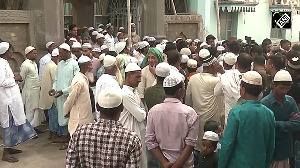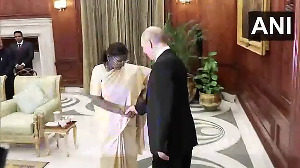'In one instance of the Pakistani army's violation of the Ceasefire, I ordered a far tougher response designed to deter the enemy.'
'I warned that 'unexpected damage' to their forces will be inflicted if they continued with such ceasefire violations.'
A fascinating excerpt from Lieutenant General K Himalay Singh's Making of a General: A Himalayan Echo.
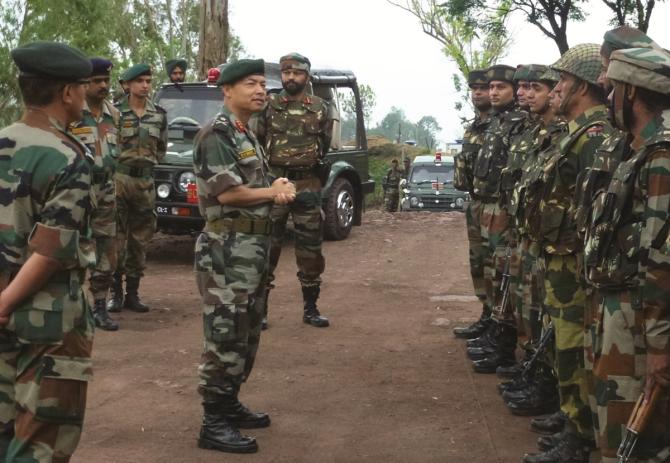
The stars had connived to destine me to become the first North Easterner to be made a Lieutenant General in the Indian Army.
The North East has produced two Air Force three stars from Assam, including Air Marshal Anjan Gogoi, elder brother of the former Chief Justice of India and a Sainik School Goalpara alumni.
It was a flattering experience to see The Indian Express, Delhi edition, put my promotion story on the front page.
Many complimentary messages poured in from various dignitaries, including one Governor and two chief ministers of some states in the North East.
How I wished that my parents were alive to hear the news. My wife and daughters have borne the brunt of separation during my army career.
My wife has brought up the girls almost single-handedly in my long absences due to operational reasons.
My brothers, sister and other relatives were celebrating my promotion too.
The period between 2014-15 at Nagrota in J&K was relatively peaceful for the Army. Militancy in the south of Pir Panjal was already on the ebb.
I was fortunate to have served in the area multiple times in the past. I settled down quickly to the new place.
The official residence of the Corps Commander is named 'Kopje', a beautiful house on the banks of Tawi River.
The Tawi River is at least 700 metres wide in front of the Kopje. The house was named 'Kopje' by Lieutenant General J F R Jacob, PVSM, who was the first Corps Commander of the Nagrota Corps and later became a Governor of a state.
In Tunisia, Africa, 'Kopje' means 'a small hill in a generally flat area'. General Jacob perhaps named the house in memory of his war campaigns in Tunisia during World War II.
From the lawns of the house, the Tawi riverbank provided a most picturesque view.
Most members of my immediate family visited us during my tenure there. As the Corps Commander, I was also one of the ex-officio security advisors to the government of J&K.
There was regular interaction with His Excellency Shri N N Vohra and Shri Omar Abdullah, the then Governor and Chief Minister of the state, respectively.
I was grateful for their valuable inputs to enable me to see things in the state from their viewpoints.
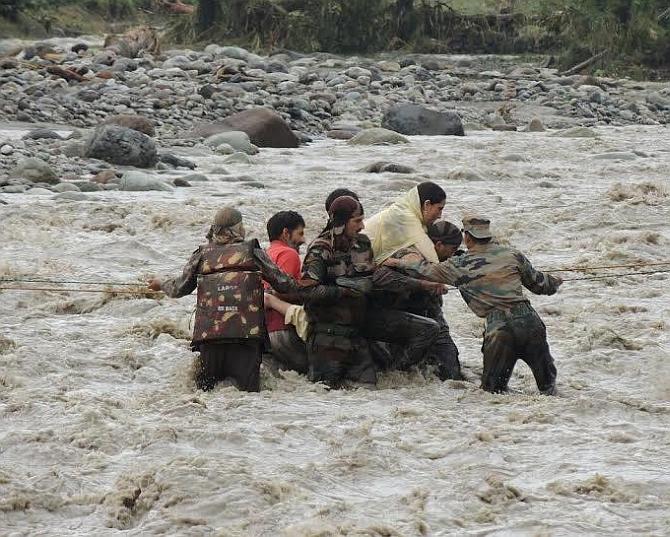
The flood in the state during September 2014 was one of the worst in recent years. 'Operation Megh Rahat' was launched to save lives and property in the entire region.
Thousands of homes were destroyed. Thousands of residents were displaced. Our troops carried out flood relief in the most trying circumstances.
I recall one night it was reported that about 30,000 people were walking from the valley along the road towards the Banihal Pass and beyond to Ramban.
It was a mammoth task to manage the huge crowd of hungry people who migrated from the valley en masse. There were roadblocks due to mudslides in many places.
Immediate action was needed to feed the crowd, provide medical attention and to evacuate them to safer places with some assistance from the civil authorities.
Next morning all available helicopters were deployed for their rescue and to drop food items for the stranded crowds at various locations along the highway.
Medical teams and rescue parties were pushed into action early morning. It was easier for the army to respond since we were physically deployed all along the Srinagar Highway. And we had the resources to help the administration.
Later it turned out that the count of the crowd inching towards Ramban was almost 50,000 in strength. Meanwhile 'Kopje' was also affected by the flooding Tawi River.

In the anti-terrorist operations, there were many encounters where many jehadi militants were eliminated with ease by the forces.
I often shared my thoughts as to the reason why the Muslim majority areas in the Pir Panjal Ranges and the Chenab Valley areas remained peaceful while Srinagar valley was always in the news for violence.
Kishtwar, Gulabgarh, Gund, Doda and other such towns were in the lap of the Pir Panjal, neighbouring Srinagar valley.
These areas had sizeable Kashmiri population even though the Gujjars, Bakarwals and Pahari Muslims were the majority.
Though these areas were in proximity to the valley, they remained physically isolated due to snow in the Pir Panjal Ranges except for the passes which were well guarded by the army.
The resources required for militant activities were not available in the foothills and in the south of Pir Panjal Ranges.
During the period 1990-2004, before the LoC wire fence came into existence, the resources to assist the militants were flowing in abundance from across the LoC.
The LoC fence which came up in the Corps Zone made this flow of resources much more difficult for the militants.
The radical groups were not able to radicalise the migrating tribes of Gujjars, Paharis and Bakarwals who comprise the majority in the foothills of Pir Panjal Range.
The militants attempted multiple times to use tunnels in the Akhnoor area to infiltrate to our side. But each time their nefarious designs were defeated.
The trans-Pir Panjal road along the erstwhile Mughal Road which connects Srinagar with Jammu through Rajouri and Shopian was also well guarded against militant activities.
Radical Islam was yet to make a full impact along the foothills south of Pir Panjal even though cases of radicalisation were reported in areas like Mendhar, Poonch, Doda, etc.
The mixed population of many tribes in the area did favour the Security Forces. The narrative in the valley was beginning to change during 2013-2014 for the worse with the idea of ISIS and Caliphate raising its head.
During this period the use of the internet as a weapon of the terrorists was clearly visible.
Social media became a tool for terrorists' activities, particularly to recruit young people and to propagate their ideologies.
Social media propaganda became more and more effective among the militants as exemplified by the rise of young people like Burhan Wani during 2014.
Thousands of militancy-related pictures and videos consumed the Kashmiri youth and propelled them to join the jihad as they were highly inspired by the propaganda machine through the Internet.
A new phase of jihad in the virtual world thus emerged in the state sometime during the period.
Social media was also used by militants to discredit the state and glamorise their narrative of gun culture among the local youth.
While we in the Security Forces were counting the number of militants neutralised by us, the likes of one dead Burhan Wani mobilised hundreds of subverted minds.
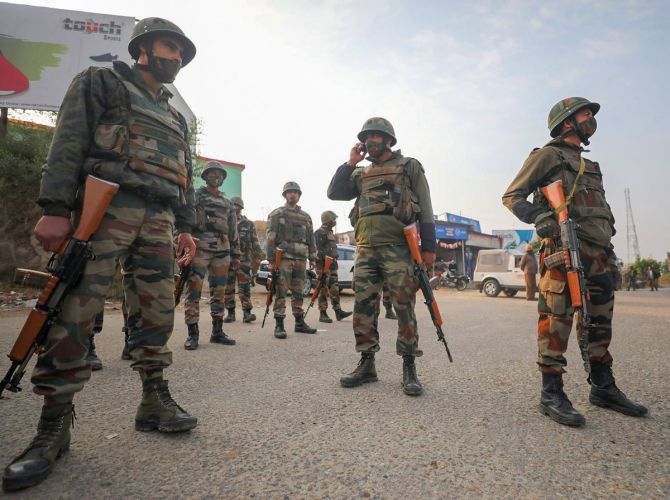
In one instance of the Pakistani army's violation of the Ceasefire, I ordered a far tougher response designed to deter the enemy.
I also warned that 'unexpected damage' to their forces will be inflicted if they continued with such ceasefire violations.
The statement was prominently covered in Pakistan's Dawn newspaper on 22 July 2015. It read:
Indian Army's Lt General K.H. Singh warned, 'here are certain elements in Pakistan who want to create trouble on the LoC... We have to give unexpected damage to them so that they don't repeat it in future'.
The statement was trolled on social media by hundreds of Pakistani youth in the next few days.
Ceasefire violations on the LoC were nothing new. We were prepared to give very strong responses at that time.
The year 2015 saw an overall increase in the intensity and the scale of heightening tensions in the state and the LoC.
The situation worsened further in the LoC and the Indian Army was forced to carry out Surgical Strikes across the LoC in September 2016 nearly a year after I left the Corps.

Counter-infiltration operations in the Srinagar-based Chinar Corps in the north whose operational role comprised the whole of the Valley and the mountains surrounding the valley were more challenging in view of the tougher terrain there.
While the infiltration of militants in the area south of Pir Panjal was almost reduced to zero levels the same could not be said in the area north.
The policies of the Central Government towards the Kashmir problem have also been wavering from time to time depending on the personalities involved in the process.
In fact, there never was any Kashmir policy in the true sense that I knew of.
It was the Security Forces at the tactical level trying to stop infiltration, to neutralise the terrorists, patrol the cities and towns, and win the hearts and minds through 'Op Sadbhavana', a small measure to engage the young in schools and colleges.
Serious engagement at the political, diplomatic, and at the socio-economic front was missing for many years. No attempts were made towards the de-radicalisation of the youth.
In other words, we seemed to focus more on the tactical success of killing terrorists while the more important issues were left unattended by those who ought to have done so.
Sun Tzu wrote on the art of war, 'Tactics without strategy are the noise before defeat'.
Kashmiris as individuals were completely different from the group behaviour that was displayed in the streets.
The Kashmiris are friendly, God-fearing, soft-spoken and endowed with all the good qualities of the Sufi culture.
However, public discourse and violent activities of throwing stones at the army and police forces present a different group behaviour pattern mostly influenced by the radicalised ideology.
Excerpted from Making of a General: A Himalayan Echo by Lt Gen K Himalay Singh (Retd) with the kind permission of Konark Publishers.
